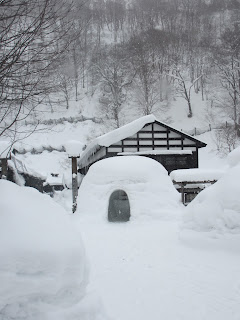 |
| Tsurunoyu Onsen |
After our stay in a provincial city, it was time to go really rustic: off to the heart of the Japanese countryside. Japan has many natural hot springs, and for millennia the Japanese have greatly enjoyed visiting these springs and soaking in their waters, partly as a relaxing getaway, partly for health reasons (the waters are supposed to cure a great variety of illnesses). Many of the hot springs have been tourist destinations for centuries, and remain popular today.
Nyuto is a hot springs resort deep in the mountains of Akita prefecture (like the dog: the breed was originally from here). There are seven different lodges, each with its own personality, but we chose to stay at the oldest and most traditional, Tsurunoyu Onsen. The inn dates back to the 17th century, when it was a retreat for the lords of Akita.
It's a little bit complicated to get there (from the train station, you take first a 50-minute bus ride and then a 15-minute shuttle provided by the inn: you must call ahead so that they can come pick you up). It's also a bit complicated to stay there, because Tsurunoyu is extremely popular (they often fill up six months in advance, perhaps partly because of all the Japanese repeat customers: we met a man from Tokyo who has visited twice a year for the last ten years). They also only take reservations over the phone (and since there is only one person at the inn who speaks any English, this can be tricky).
 |
| R and I on the shuttle: the scenery is gorgeous because we are in the middle of nowhere |
But the experience was worth every bit of effort. It's one of the most magical places I have ever been, a collection of rambling wooden structures built in traditional style built along (and over) the freely flowing hot springs, surrounded by pristine countryside. The interior is equally charming, with eccentrically bending wooden hallways, tatami-covered rooms and doors hand-painted with scenes of nature.
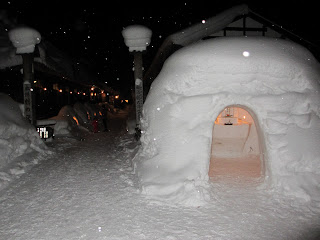 |
| Entryway to the inn: the igloo is actually a shrine to the water god |
 |
| We arrived at night so in reality (and without the flash) it looked more like this |
 |
| The small lit snow pyramids are "homes" made for the local kappas (a kind of Japanese water spirit) |
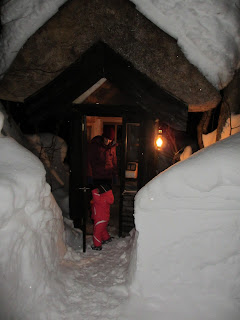 |
| The world's most charming phone booth (R loves playing with phones): there is no cell phone reception |
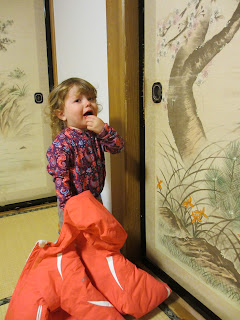 |
| Door to our entry room (our room was quite large and divided into three sections: entryway (with toilet in a small closet off of that); main room; and sitting'porch area, filled with windows overlooking the stream: R is crying because she wants to go play in the snow right NOW! |
 |
| R sleeping: even though she was too restless of a sleeper to stay in bed, the tatami made the floor pretty comfortable |
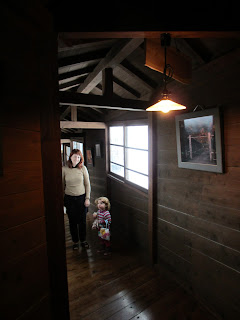 |
| Hallway to our room, curving at all kinds of crazy angles |
 |
| Breakfast room |
The baths at Tsurunoyu are also pretty special. There are four, but my favorite was the large outdoor bath. Sitting in the perfectly warm, milky water (due to the natural minerals) as snowflakes gently fell on my head, surrounded by beautiful mountains, was absolutely incredible. Since Tsurunoyu is so traditional, the outdoor bath is mixed sex (this used to be standard in Japan, before contact with the West changed their attitudes about nudity: all bathing in Japan is done in the nude). We felt this was an advantage, since it meant the whole family could bathe together, including R. She LOVED the hot springs and wanted to stay there indefinitely: in fact, she cried bitterly every time it was time to get out.
 |
| This passageway connects the main building to one of the bathhouses |
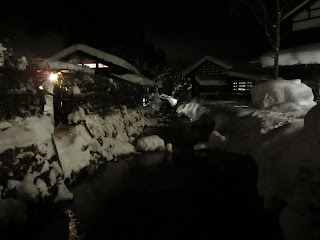 |
| All the inn's buildings |
 |
| The outside bath (from TripAdvisor) |
Part of the Japanese inn experience is the food. Typically breakfast and dinner are provided by the inn (in fact, their cost is usually included in your room rate). The food is usually kaiseki (Japanese haute cuisine). Each meal consists of numerous small dishes (dozens, sometimes), each one painstakingly arranged on carefully selected plates. Proper presentation of a meal is an art form, which ideally perfectly balances appearance, color, taste and texture.
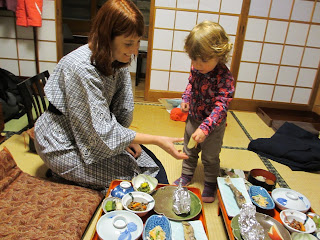 |
| Having dinner (this is actually only about half of the full meal) |
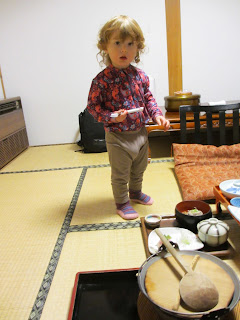 |
| More food, including stew, sashimi and mountain yam |
Kaiseki uses only fresh, seasonal ingredients (important as the point of the preparation is to enhance the natural flavor of the food, rather than change it). Kaiseki also makes heavy use of locally sourced ingredients, as was the case at Tsurunoyu (regional differences are very important in Japan, so each little area has its own food traditions). As a result, the menu changes daily, though it will probably include raw fish (sashimi and sushi), cooked fish, picked vegetables, miso soup and rice.
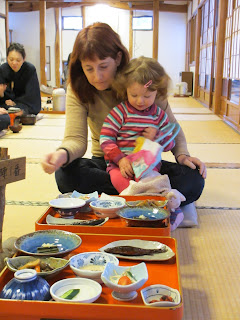 |
| At breakfast: R is not impressed with my whole fish |
I don't speak Japanese, so have no idea exactly what we were served (though it did include perhaps 20 different kinds of mushrooms, prepared in every way possible, and "
mountain yam"). It was extremely delicious, however, even the whole roasted fish with its eyes and scales still on (which is saying something, as usually I dislike seafood).
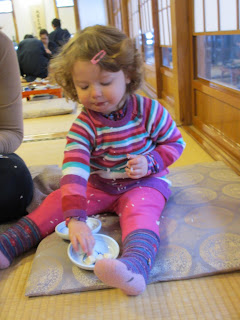 |
| R is not a fan of kaiseki: she sticks to rice (and ice cream, handily for sale at reception) |
I highly recommend a stay at Tsurunoyu: it was one of the highlights of the trip for me. We stayed two nights, but if you are in search of a truly relaxing experience I recommend staying longer and exploring the other nearby hot springs. Spending several days eating delicious food, taking baths and admiring the scenery, all while surrounded by excellent service (the staff, as is typical in Japan, were all extremely competent and awe-inspiringly polite), is definitely something I'd like to do when not accompanied by a very active toddler.
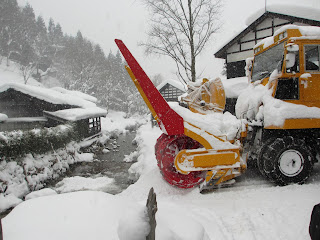 |
| The inn has its own snowblower machine, necessary because it's so out in the country |
 |
| They had to clear a path for us to leave: R loves the machine |
I don't comment often, but I just wanted to say thank you for sharing your family and adventures! Don't ever stop!! It is the most interesting blog I have ever read because you seem so real in your descriptions of life!
ReplyDeleteWow, thanks so much for such a sweet comment!
DeleteI feel like such a prude, but I wanted to clarify - you bathed nude in the springs with other men and women you don't know? American culture is so puritanical that I can't even imagine this! I think it's cool. And probably helps you see that everyone has different bodies (something we aren't confronted with enough in the USA)
ReplyDeleteYes, bathing in Japan (at least at hot springs resorts) is pretty much always communal. The difference is whether it's sex segregated (men only, women only) or mixed sex. It's really not a big deal though, because the Japanese are so incredibly polite and socially considerate. I actually thought it was a lot less awkward than changing in the locker room at an American gym.
DeleteAs far as modesty goes, at Tsurunoyu you really can't see anything due to 1. the natural color of the water and 2. the steam. Plus we bathed at night so visibility wasn't good anyway. They actually have a separate "hidden" entrance for women, so you can enter the water unobserved; men do have to bare it all for the brief walk from their changing room to the spring though.
There's a Japanese bathhouse in SF (single sex though!) that's fun if you ever want to try it out.
It looks beautiful! I can't believe how much snow there is. I've been to Japan but I would love to go again some day!
ReplyDeleteI've been to a nude hot springs in the States- in Steamboat Springs, CO. It was dark enough that you couldn't see anything (I mean, really dark, I was worried about tripping getting into the water!). But it was very freeing. :)
That sounds like fun too! I've never been in Colorado, but hopefully someday?
Deletehi! Thanks for sharing! it is a very nice post! we are thinking to go to the same onsen... did you go before or after end of the year? which room did you choose?
ReplyDeletehttp://www.tsurunoyu.com/FONDMENT/t-heya.html
Thank you very much!
We stayed there after the end of the year (in January, that is). I don't remember which room we ended up staying in: we just took whatever was available as they fill up very quickly. We wanted to stay there on our next trip but they had no availability that time :( so book ahead if you are planning on going !
DeleteThanks for the advise, Grace!
Delete